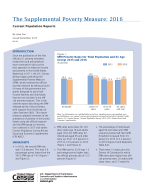The Supplemental Poverty Measure: 2016
The Supplemental Poverty Measure: 2016
Introduction
Since the publication of the first official U.S. poverty estimates, researchers and policymakers have continued to discuss the best approach to measure income and poverty in the United States. Beginning in 2011, the Census Bureau began publishing the Supplemental Poverty Measure (SPM), which extends the official poverty measure by taking account of many of the government programs designed to assist low-income families and individuals that are not included in the official poverty measure. This is the seventh report describing the SPM, released by the U.S. Census Bureau, with support from the Bureau of Labor Statistics (BLS). This report presents updated estimates of the prevalence of poverty in the United States using the official measure and the SPM based on information collected in 2017 and earlier Current Population Survey Annual Social and Economic Supplements (CPS ASEC).
Erratum Note
The U.S. Census Bureau identified an error in the input of SPM thresholds for renters used in the 2016 SPM data products. The base threshold should have been $26,104 and was erroneously entered as $26,014. This error affected the SPM poverty status for 109 unweighted observations. As a result, the overall SPM poverty rate was understated by 0.06 percentage points—13.91 in published tables compared to 13.97 percent. Corrected tables, research files, and a revised report have all been reissued.
This Erratum Table provides a comparison of the revised SPM 2016 estimates to the previously published SPM 2016 estimates for all groups included in Table A-1 of the report.
Highlights
- In 2016, the overall SPM rate was 14.0 percent. This was 0.5 percentage points lower than the 2015 SPM rate of 14.5 (Figure 1 and Figure 2).
- SPM rates were down for children under age 18 and adults, aged 18 to 64. SPM rates for individuals aged 65 and older were up, from 13.7 percent in 2015 to 14.5 percent in 2016 (Figure 1 and Figure 2).
- The SPM rate for 2016 was 1.3 percentage points higher than the official poverty rate of 12.7 percent (Figure 3).
- The percent of individuals aged 65 and older with SPM resources below half their SPM threshold increased from 4.5 percent in 2015 to 5.2 percent in 2016 (Figure 6 and Appendix Table A-4).
- There were 13 states plus the District of Columbia for which SPM rates were higher than official poverty rates; 20 states with lower rates, and 17 states for which the differences were not statistically significant (Figure 7).
- Social Security continued to be the most important anti-poverty program, moving 26.1 million individuals out of poverty. Refundable tax credits moved 8.1 million people out of poverty (Figure 8).
Figures
Tables
Others in Series
Publication
Publication
Publication







